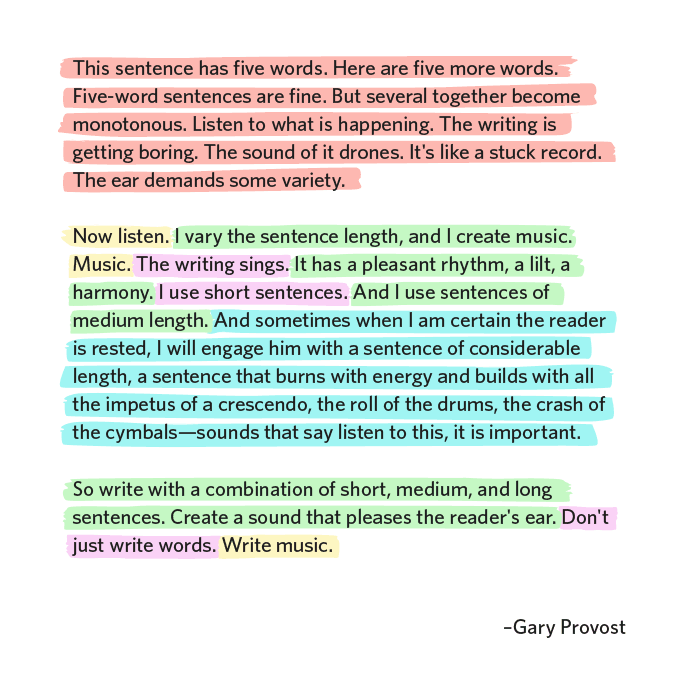Writing
About how to write properly
1 The Elements of Style
William Strunk and E.B. White’s short and famous book, The Elements of Style.
Rule 17
A sentence should contain no unnecessary words, a paragraph no unnecessary sentences, for the same reason that a drawing should have no unnecessary lines and a machine no unnecessary parts.
This requires not that the writer make all his sentences short, or that he avoid all details and treat his subjects only in outline, but that every word tell.
2 Making writing more varied
2.1 Composition
Design - choose a structure in advance, when planning what to write, and hold onto it.
Paragraphs - the primary compositional unit of writing. Each paragraph should be about an individual topic or speech. Begin paragraphs with a sentence that gives the topic or helps with the transition. Break paragraphs apart if it helps the reader, not just for the hell of it.
‘After the paragraph has been written, examine it to see whether division will improve it.’ (Page 32)
Active voice - it’s much better to use the active voice in most cases. E.g.:
- ‘A report was prepared,’ is not as good as;
- ‘He prepared a report.’
Not - say what things are. Don’t waste your time saying what they are not.
Be definite - do not dance around the truth express it in concrete terms.
Omit needless words - ‘this is a subject that’ can better be written as ‘this subject’.
Summaries and Tenses - in a summary, or anywhere really, pick a tense and stick to it, otherwise you’ll confuse the reader.
Emphasis - put the word or words you want to emphasise at the end of a sentence
3 Making a proper CV
3.1 GitHub resources
LINKS: Markdown supports two style of links: inline and reference. In both styles, the link text is delimited by [square brackets].
3.2 CV examples
3.3 Crafting Your CV with Authenticity, Clarity, and Value
By following these principles, you can create an authentic, clear, and compelling CV that effectively communicates your value proposition to potential employers.
Authenticity
- Be genuine in portraying yourself: reflect your professional path.
- Use language that reflects your personality and experiences truthfully.
- Avoid overused buzzwords, emotional lenguage or exaggerated claims.
- Highlight your real strengths, tasks done, and achievements.
Action Verbs
- Recommend using action verbs that reflect executive, planning, revisioning, etc.
- Examples include: orchestrated, spearheaded, devised, formulated, strategized, reimagined, restructured, colaborated, created, designed.
- It should sign to participate into Agile teams.
Clarity & Vocabulary
- Keep language simple and concise.
- Use active voice and straightforward sentences.
- Avoid jargon or overly technical terms unless necessary common tech vocabulary.
- Clearly communicate skills, experiences, and accomplishments.
Value
- Emphasize quantifiable achievements.
- Focus on meeting targets, increasing efficiency, or solving specific problems.
- Use action verbs and concrete examples to demonstrate impact.
Tailoring
- Customize CV for each job application.
- Highlight most relevant skills and experiences.
- Align CV with company values and role requirements.
Storytelling
- Tell a compelling career journey.
- Showcase key moments, challenges overcome, and lessons learned.
- Connect with recruiters on a deeper level.
Proofreading
- Ensure CV is error-free.
- Double-check grammar, punctuation, and formatting.
- Seek feedback from trusted sources.
Honesty
- Be transparent about skills and experiences.
- Highlight genuine strengths.
- Prepare to discuss areas for growth or development.

